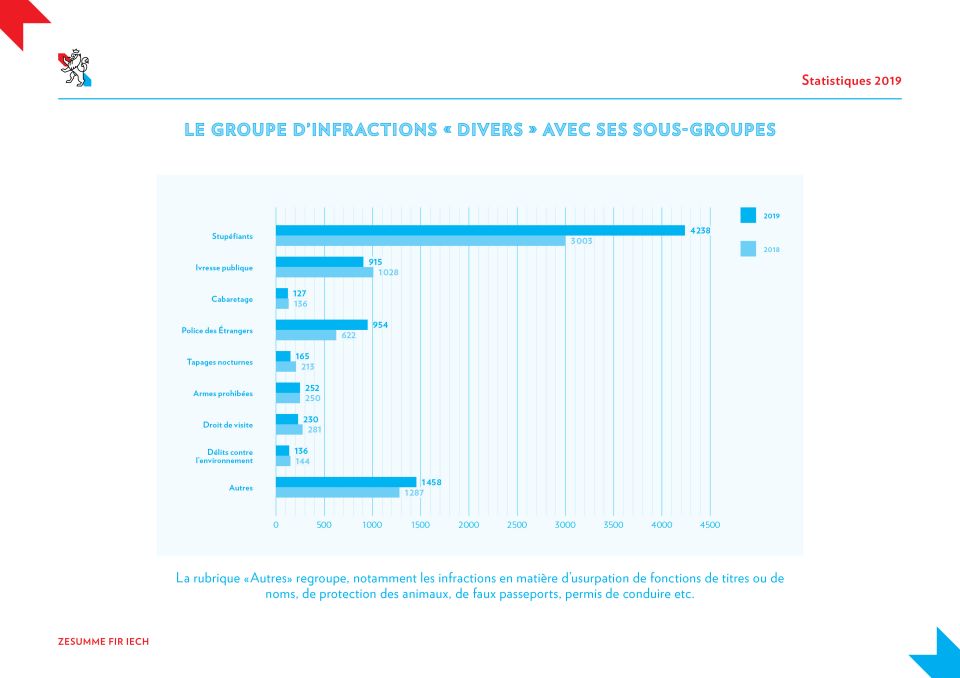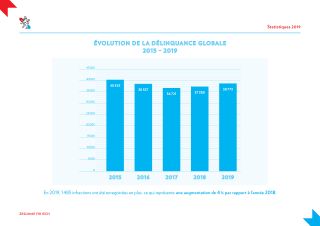Exceptionally, due to current circumstances regarding Covid-19, the crime trend statistics for 2019 were not presented to the press in spring at a press conference, but will be set out in this report.
This communication aims to report on the general trends that were observed in 2019, providing an explanation of the meaning and interpretation of these data. An initial communication focuses on the general figures and offences against property and persons. A second communication covering drug-related crimes and burglaries will follow in the next few days.
Caveats and guidance on the interpretation of the data
While these figures reflect the work of the Police, there are a few caveats: firstly, a single event may represent several offences; secondly, an event may be re-categorised by the Public Prosecutor as a result of the ensuing investigation. Cases may also be dismissed by the judicial authorities and so result in acquittals. The data contained in the police statistics therefore only provide basic information. The number of events is made up of offences that have been identified by police officers, as well as those reported by members of the public. Aside from this information, there are bound to be some "grey figures" for the different categories of offence as, logically, these statistics include only offences that the Police are aware of.
It should also be emphasised that police statistics are primarily there to assist the work of the Police units who, after analysing these statistics, can gradually adapt their working methods over the year and react to the changing trends in terms of their investigation, prevention and enforcement methods.
General trends
Overall, there was a slight upward trend in crime of 4% between 2018 and 2019, to around 38,800 offences recorded by the Police in 2019 - a figure which, despite the growth in population, is still below the figure of 40,000 offences recorded in 2015. This general drop over the last few years can be seen, in particular, if we compare this figure with the number of inhabitants in order to establish the rate of criminality per 100,000 persons, as shown in the graphs below.
Crime against property typically represents the majority of offences. Compared with 2018, the number of offences reported to the Police in this category fell by 3%. However, crime against persons reported to the Police increased by 8.9%.
Crime against property
Theft with violence has been fairly stable since 2016 and remains at a significantly lower level than in 2015. No armed robberies on banks or cash-in-transit companies have been recorded for several years. In 2019, 8 armed robberies on other businesses and establishments (bookshops, food shops/supermarkets, jewellers, etc.) were recorded.
For theft involving vehicles, the overall figures fell between 2018 and 2019. This category mainly includes theft of items from inside a vehicle. Other types of theft, including for example shoplifting and pickpocketing, fell by 3.6% over the same period.
Crime against persons
In the case of crime against persons, however, there was an increase of 7.4% in cases of assault and wounding with intent between 2018 and 2019.
An increase in cases of domestic violence reported to the Police was also observed between 2018 and 2019.
The term "Miscellaneous offences" covers various categories, including drug-related offences in particular.

The police clear-up rate is at its highest level for the past five years, up more than 8% since 2015. A case is considered to have been cleared up if it has been possible to identify the alleged perpetrator ("person likely to have participated in an offence"). There is a presumption of innocence until proved guilty.

Burglary
Under the heading of burglary, the police statistics define two types of location: burglaries in residential premises (houses, apartments, basements) and burglaries in non-residential premises (shops, businesses, restaurants, site huts, etc.).
The majority of burglaries involve residential premises. A positive trend can be seen in this category, with a reduction of over 7% between 2018 and 2019. Burglaries in non-residential premises rose slightly by 1.59% during the same period following a sharp drop in the previous period.

Generally, burglaries in residential premises mainly occur in urban areas, close to major roads and close to borders. In terms of timing, most burglaries take place on Fridays and Saturdays and in the early evening. During the year, burglaries are traditionally more frequent at the start of summer or in the winter months, due to early nightfall. The Police are therefore particularly active in fighting burglary during these times. In 2019, there was no clear peak at the start of the summer, unlike in other years.

All these figures do, of course, refer almost exclusively to "traditional" burglaries, in which the perpetrators enter via a door, window, across a balcony, etc. without occupants being the target. The number of cases of "homejacking" (theft with violence or threats in residential premises) is very low compared with total burglaries: In 2019, there were 5 homejackings in residential premises.
Fighting burglary is one of the main priorities of the Police. A daily analysis of the most recent trends provides the basis for the adoption of prevention and enforcement measures.
These preventive and proactive efforts include, for example, targeted patrols and increased police presence at key times and in key locations, also public information sessions, information via Police communication platforms or personalised advice provided by officers from the National crime prevention service. Reactive and enforcement efforts include the search for perpetrators, door-to-door enquiries, identification of traces by crime scene investigators, investigations by the Criminal investigation department or the deployment of plain-clothes or uniformed resources.
An important point to remember is that burglars do not usually seek confrontation with the occupant and leave once they realise they have been spotted. However, if an occupant becomes aware that they are being burgled, they are advised not to directly confront the burglar. They should immediately alert the Police using the emergency phone number 113 and indicate that they are aware of the burglar's presence, for example by making a noise, shouting or switching on the light.
The fight against drugs
The fight against drugs is another main priority in Police work and they were particularly active in this field in 2019. In fact, the trend shows a significant increase in cases between 2018 and 2019. This particularly refers to the number of cases of possession, up 35%, and drug use, up 51%. There was a 21% rise in drug trafficking. The number of drug seizures, in cooperation with the Customs and Excise Agency, rose to 1,412 in 2019, while the number of arrests fell slightly.
From prevention via a presence on the ground to criminal investigations, all Police units are committed to and actively engaged in the fight against drugs, whether through preventive patrols, information-gathering or via wide-ranging checks.
And the Police are not the only agency working on this. The Police service works in close cooperation with the judicial authorities and the Customs and Excise Agency. Together, they have seized over 359,000 grams of cannabis, 6,400 grams of heroin, 1,747 grams of cocaine 50,997 ecstasy tabs and 57 grams of amphetamines.

Whether concerning the general fight against crime or the fight against specific criminal activities, on our website we offer comprehensive information and advice on prevention, as well as assistance for victims. We generally advise members of the public to report immediately to the Police any suspicious persons or events they have witnessed, so that checks can be made and the necessary action taken.
















